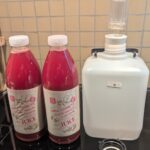Simple Homemade Fruit Juice Wine
An easy basic wine recipe step by step walkthrough, fermenting storebought fruit juice of your choice with no specialized ingredients or equipment required.
Yield: 2 standard wine bottles yield
Materials
- 2 L packaged fruit juice (or 64 oz.)
- 200 g granulated sugar
- ¼ teaspoon dry wine or cider yeast much preferred
- OR dry baking yeast less predictable and flavor can suffer
Yeast Nutrients
- 1 teaspoon dry baking yeast plus
- 50 ml boiling water
- OR commercial wine nutrient according to package directions
Optional Addition
- 1 g pectic enzyme powder for better clarity with pectin-heavy fruits
Instructions
Starting Preparation
- Preferably let your juice come up at least close to room temperature before using it. The yeast will take off better that way, and the sugar should be easier to dissolve.
- Assemble your supplies.Here we've got the basics: 2L of juice, a food-safe container big enough to hold it with some extra headspace over top of the liquid to allow for bubbling, a bag of sugar, some additional nutrients to keep the yeast happy and not putting out off flavors or smells, and some yeast to ferment it with.A clean empty gallon/3-4L milk or other drink jug will work great for 2L of juice.You will also want some way of sanitizing your equipment, as discussed above. In this case, it would be the bottle of Chemsan sitting over to the left.Also a couple of optional extras: Powdered pectic enzyme which I keep around anyway, since this juice blend has an apple base and they are very high in pectin. This should help the finished wine look clearer, but is really not necessary.This jug also has a fermenting stopper with airlock already fitted. Both are also available fairly cheaply online or from brick and mortar brewing supply shops. But, if you don't have an airlock, you can make do without.
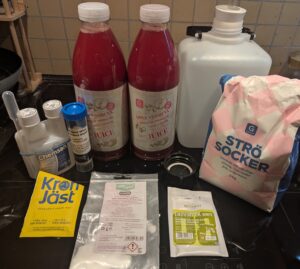
- Mix your sanitizing solution according to directions. (Again, see the note just above the recipe.)I just put it into the brewing jug, with water up to the 2L line that I marked. It will need to be flipped upside down in a couple of minutes, to make sure the entire inside surface is treated.The pot over to its right is going to hold the sanitizer once the jug is done. You will also want to sanitize a funnel for pouring in your ingredients, unless you're using a wide mouthed jar.We are working in a very clean sink for now, to catch any drips or spills.
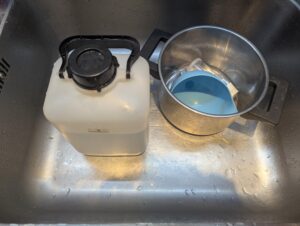
Ingredient Time
- Measure out your sugar. We're aiming for 200g here.
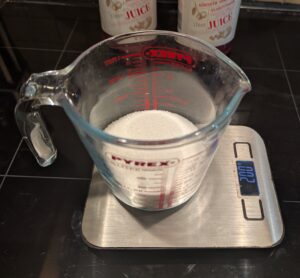
- As you can see, this comes out to just under 200ml after I shook it down some to level it which compacted it down a bit. With the plain granulated sugar grain size that we get here, I generally do just measure out 200ml for a batch like this.The weight to volume may vary a little with your particular sugar. But, this isn't exactly rocket science, it's wine for our own consumption. 200ml or ¾ cup should be fine to get a table wine alcohol level.
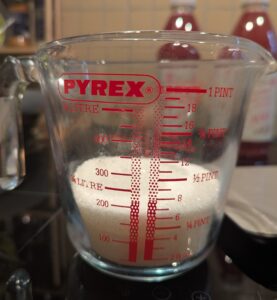
- I did decide to just go with bread yeast as a nutrient addition, to demonstrate. Yeast are little cannibals who will merrily eat their fallen comrades.The easiest way to do this is with the microwave. Just add about a teaspoon of dry baking yeast into a mug.We can save the rest of the pack to use later, as I'll show in a bit. The little sauce cup over to the side holds the optional pectic enzyme.
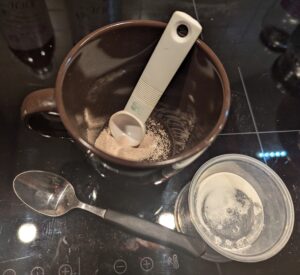
- Douse it with around 50ml/a little under ¼ cup of preferably boiling water. Mix well. Microwave for maybe 30 seconds, or until it's definitely boiling. We want to make sure this yeast is killed off.You can also bring it up to a good boil in a small pan on the stove, but it will probably need more water.
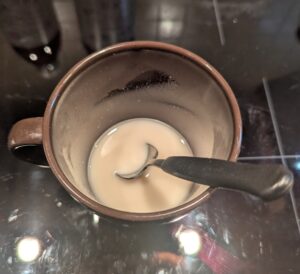
- Time to start pouring!I did also flip that funnel over, to make sure all parts were sanitized. The jug's screw-on lid is waiting in the bath now.
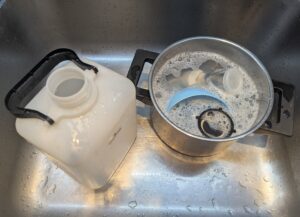
- Shake the juice well if it's cloudy, and pour around half of it into the jug.We are trying to avoid a layer of sugar clumping up on the bottom too badly.
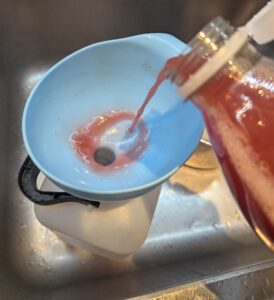
- Pour in the sugar and any other dry additions you may be using.I used another dry funnel, and just set the wet one on top of the empty juice bottle to keep it clean. I'm personally fine with using a clean but unsanitized funnel with dry ingredients like this. A clean piece of paper rolled up into a funnel shape will also work. You can use the same one and try to wash the sugar down with the remaining juice if you prefer, or don't have a second one.
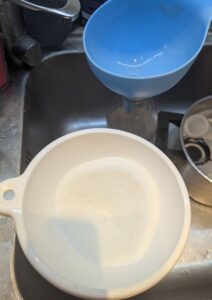
- Pour in the boiled yeast water if you're using it, and the rest of the juice.
- Put the lid back on, and tighten it down.Now it's time to shake-shake-shake to dissolve the sugar as well as you can. I find it helpful to shake, let it sit a few minutes, then come back and shake some more. The shaking should also help aerate the juice to the yeast's benefit, especially early on in the fermentation.
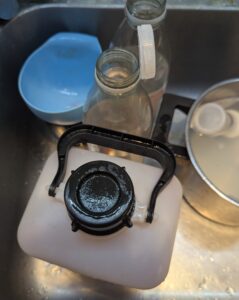
- With this jug and its top handle setup, I prefer to carry it to the Nerd Brewing Corner with the lid still on. It's awkward to carry with the tall airlock.You'll want to find a fermenting spot where your container can sit out of the way at a normal room temperature for a few weeks, out of direct sunlight. A cabinet or closet will work. I like to keep mine out where I can more easily see what they're doing.
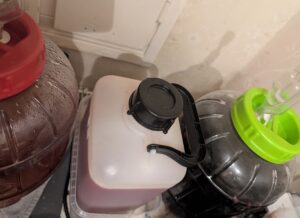
- Tip: You will want to put some sort of tray under the container for at least the first week or so, to catch any potential overflows. A lot of foaming and bubbling is likely to happen early on, as our tiny yeasty buddies go wild on all those sugars that we gave them.It is much less likely to overflow with the amount of space over top that I've given it here. But, it will still occasionally happen, so better safe than with sticky fermenting juice running all over the place! Ask me how I know.
Fermentation Time
- Now that the jug is safely in place, it's time to start this fermentation.You will only need less than a full ¼ teaspoon measuring spoon of dry yeast for this size batch. It will multiply quickly.(See notes for more on yeast choice.)
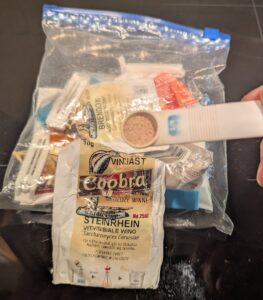
- Now with the yeast in, and the lid swapped for the airlock stopper.If you don't have an airlock, you can leave the lid on--but, IMPORTANT: loosen it so that gases from fermentation can get out. You only want it to be barely on the threads at all. Yeast fermentation will bubble like mad, blowing off an amazing amount of carbon dioxide gas. It can also foam up and gum up the works so it can't vent, if the lid is only loosened a little to where it's not airtight anymore.
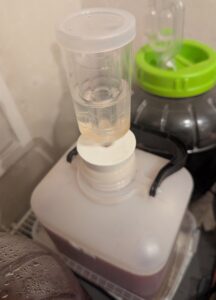
- Have fun!BREWING UPDATES will be posted as this batch progresses. (opens in new tab)
